 Subscribe
Subscribe- Login
-
/
Sign Up
- US Black Engineer
- >>
- News
- >>
- Barbara Whye on Intel Diversity Midyear Report
In June, Intel rolled out the historically black college and university (HBCU) Grant Program, a three-year $4.5 million initiative to encourage students to remain in science, technology, engineering, and math (STEM) pathways at six HBCUs that produce more than 33 percent of America’s black engineers, scientists, and technologists.
This week Intel released its mid-year diversity and inclusion report.
“The 2017 mid-year diversity and inclusion data show where we stand now,” wrote Barbara Whye, vice president, human resources and chief diversity and inclusion officer, in an Intel editorial.
“Our overall gap to full representation in the U.S. has narrowed from 2,300 people in 2014 to about 800 today – a 65 percent improvement that we’re very proud of,” she said. “Encouragingly, we’re seeing a stable progress of female, Hispanic and Native American representation.”
‘More work to do in achieving full representation by African Americans in technical roles’
Barbara conceded however that there’s “more work to do in achieving full representation by African Americans in technical roles.”
“We also know retention must remain a key focus,” she added. “Our innovative retention WarmLine is one of the ways we are addressing the gaps. The WarmLine has achieved a 90 percent success rate across well over 6,000 employees who have used it.”
As deputy director of Intel’s Diversity in Technology (DiT) Initiative, Barbara Whye led the strategy and execution of Intel’s recently announced the commitment of a $300M Diversity in Technology (DiT) Fund.
Barbara is responsible for developing the implementation design of the Fund that positions Intel to achieve its 2020 full representation of women and underrepresented minority goal.
As part of her oversight, she also leads the team focused on DiT Fund investments in the education pipeline focused on Intel’s workforce development needs.
Prior to transitioning to the philanthropic side of Intel, she spent 15 years in key leadership and project engineering roles responsible for acquiring and starting up new facilities for Intel Corporation. She led operations for multiple start-ups.
Barbara has a bachelor’s degree in Electrical Engineering, an MBA, and is currently pursuing a Ph.D. in Human and Social Dimensions of Science and Technology at Arizona State University.
Highlights from the Intel Midyear Diversity report
Over a three year trend, non-underrepresented employees compromise 90 percent of the total workforce.
However, underrepresented minorities in technical roles increased by 0.1 percent since 2016.
Overall full representation gap fell from 2,300 people in 2014 to 800 now, a 65% improvement.
White and Asian males, 64.6%
Females, 26%
URM, 12.6%
Hispanic, 8.3%
African-American, 3.6%
Native American, 0.6%
Click here to view Intel Diversity and Inclusion Mid-Year Report

